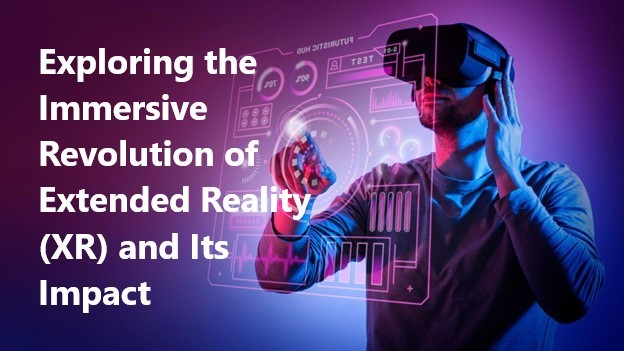Exploring the Immersive Revolution of Extended Reality (XR) and Its Impact

Extended Reality (XR) is a technology that can revolutionize how we interact with the world around us. XR encompasses a range of technologies like Virtual Reality (VR), Augmented Reality (AR), and Mixed Reality (MR). Each of these technologies offers experiences that seamlessly blend virtual worlds.
-
Virtual Reality (VR) refers to a captivating experience that fully immerses users in a computer-generated environment. By wearing a headset or goggles, users are transported to this realm, which can be enhanced with motion-tracking sensors for a realistic feel. In this world, users have the ability to interact with and control their surroundings using input devices like controllers. VR finds applications in gaming, training simulations, architectural visualization, and healthcare.
-
Augmented Reality (AR) enriches the world by overlaying digital content onto it rather than replacing reality like VR. AR enhances our view by adding digital objects, information, or experiences through screens on smartphones or tablets, smart glasses, or heads-up displays. Common examples of AR include navigation assistance and popular games like Pokémon GO. It also proves useful in maintenance scenarios where technicians can access real-time data and instructions while working on equipment.
-
Mixed Reality (MR) combines elements from both VR and AR to create experiences. In MR scenarios, digital objects or environments are seamlessly integrated into the world so that users can interact with them as if they were physically present alongside them. Mixed reality (MR) frequently utilizes headsets that have sensors to track the user’s environment. These headsets enable the placement of objects within the space. One example of a mixed reality headset is Microsoft's HoloLens.
Just imagine entering a world where digital elements seamlessly merge with your surroundings, opening up dimensions for engagement and exploration. In Virtual Reality (VR), you could find yourself standing on the surface of Mars or fully immersed in an awe-inspiring gaming realm, completely detached from reality. Augmented Reality (AR) enhances your environment by overlaying information, interactive objects, or playful characters using devices like smartphones or smart glasses. It truly elevates your experiences in various ways. Taking it a step further, Mixed Reality (MR) integrates objects into your world in such a way that you can interact with them as if they were actually there, allowing you to manipulate and engage with them physically.
Below are the significant impacts on various industries and aspects of our lives:
-
Education and Training: XR has the capacity to train and educate students by providing immersive and interactive experiences, allowing them to explore historical events, simulate scientific experiments, and engage in lifelike medical training scenarios. XR can also provide effective and cost-efficient training programs for industries like aviation, healthcare, and manufacturing.
-
Healthcare: XR technologies can also be used in medical training, surgical planning, and patient care to diagnose various diseases and provide therapies. For surgeons, they can use VR applications like “Surgical Simulators” to practice complex surgical procedures in virtual environments, enhancing their skills with low risk. For doctors, AR applications can help them easily identify diseases. Patients can also benefit from XR-based therapies and rehabilitation programs.
-
Gaming and Entertainment: XR has a significant impact on the entertainment industry. XR provides gamers with better immersive gaming and entertainment experiences through VR technologies. Virtual reality allows gamers to step into virtual worlds, making them feel like they are part of the game. XR also enhances storytelling in films and interactive media.
-
Manufacturing and Design: XR can be used for designing products, planning production lines, and training workers. XR applications allow designers to create 3D models, and workers can perform operations with the help of this technology. This can lead to better quality control and reduced risks in the manufacturing field.
-
Marketing: In the field of marketing, XR is employed to create interactive and engaging shopping experiences for customers. Larger brands use AR for interactive promotions, product demos, and virtual try-on experiences. A notable example of this is Walmart VR, which is a VR application that allows customers to shop virtually from the comfort of their homes.
These are just some of the significant impacts on various industries and aspects of our lives. XR is a powerful and innovative technology that has been developed. It has the potential to make a big impact on our lives, changing the way we do things by allowing us to experience things virtually. And the best part is, as the technology continues to improve and people come up with new ways of using XR, it's not just for gamers; it can be a tool to make our world better by solving problems in healthcare, manufacturing industries, education, and interaction with others. XR is truly amazing, making our world more fun, interesting, and helpful.
